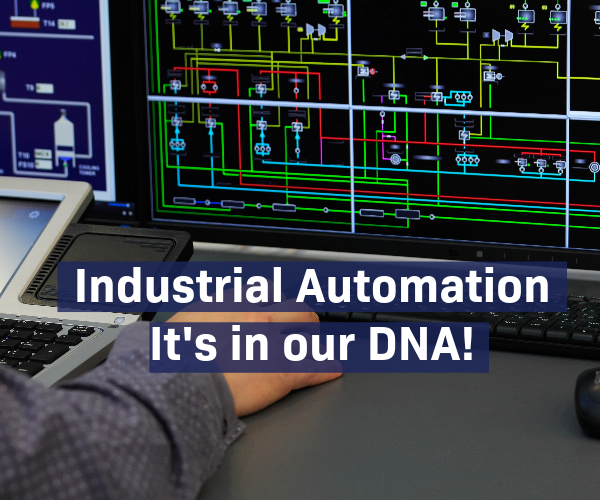In this article, we explore what is industrial automation, the benefits it delivers and how a range of industry sectors use industrial automation to drive plant efficiency.
10 min read
A quick summary for skimmers
Industrial automation revolutionises various industries by minimising human intervention and optimising operations through technology and control systems.
Key components include control systems, sensors, PLCs, HMIs, SCADA, cybersecurity, and OT networks.
Types of automation range from fixed to flexible, including CIM and SCADA systems.
Industrial automation is loaded with benefits, including efficiency, precision, reduced downtime, optimised resource usage, safety, scalability, and data-driven decisions.
Examples in mining, water treatment, energy, and oil illustrate its diverse applications. Industrial automation epitomises progress, fostering smarter, safer, and sustainable operations across industries, shaping the present and future of the technology-driven sector.
Industrial automation is the backbone of modern industry. It enables machines, systems, and processes to operate with minimal human intervention, improving efficiency, safety, and consistency. In 2025, automation is evolving rapidly—driven by artificial intelligence (AI), digital twins, edge computing, and the growing demand for sustainable operations.
For companies in mining, mineral processing, and energy, automation is no longer optional. It’s a strategic imperative. This guide explores what industrial automation is, how it works, and why it’s critical to future-proofing your operations.
Understanding what is industrial automation
Industrial automation refers to the use of control systems—such as computers, programmable logic controllers (PLCs), and robotics—to manage industrial processes. These systems monitor inputs, make decisions based on programmed logic or AI, and control outputs to achieve desired outcomes.
Automation can be applied to:
- Manufacturing lines
- Mineral processing plants
- Smelters and refineries
- Energy generation and distribution
- Water treatment facilities
Core technologies in automation:
- PLCs and DCS: Control systems that execute logic and manage distributed operations.
- SCADA: Supervisory systems that provide real-time visibility and control.
- HMIs: Interfaces that allow operators to interact with automated systems.
- Sensors and actuators: Devices that collect data and perform physical actions.
Why industrial automation matters?
Across the mining value chain, the pressure to improve output, reduce costs, and decarbonise operations is intensifying. Automation delivers measurable benefits across industries:
1. Efficiency and Productivity
Automated systems operate 24/7 with minimal downtime. They optimise throughput, reduce bottlenecks, and enable faster decision-making.
2. Safety and Risk Reduction
By removing humans from hazardous environments—such as smelters or underground mines—automation reduces injuries and improves compliance.
3. Quality and Consistency
Automation ensures repeatable processes, reducing variability and improving product quality.
4. Cost Savings
Lower labour costs, reduced waste, and improved energy efficiency contribute to significant operational savings.
5. Scalability
Automated systems can be scaled across multiple sites or processes, enabling standardisation and centralised control.
How does industrial automation work?
At its core, industrial automation involves the use of technology and control systems to manage and operate machinery and processes with minimal human intervention. It’s about automating repetitive and often complex tasks, reducing the margin for error, and optimising resource utilisation. Here’s a simplified breakdown of how industrial automation works:
1. Control systems
At the heart of industrial automation is the Distributed Control System, or DCS, which manages and regulates the processes within a system. These systems can range from simple on-off control to complex feedback-based control loops, ensuring that parameters such as temperature, pressure, speed, and other variables are maintained within desired ranges.
2. Sensors and actuators
Sensors are the sensory organs of automation, gathering data from the environment. Actuators, on the other hand, execute the desired actions based on the information received from sensors. This real-time feedback loop enables precise control and adjustment of processes.
3. Programmable Logic Controllers (PLCs)
PLCs are industrial computers designed to control manufacturing processes and machinery. They execute a set of instructions to control various components of a system, enabling seamless coordination and synchronisation.
4. Human-Machine Interface (HMI)
The HMI serves as the bridge between human operators and the automated system. It provides a user-friendly interface through which operators can monitor processes, set parameters, and receive alerts or notifications.
5. Supervisory Control and Data Acquisition (SCADA)
SCADA systems allow for centralised monitoring and control of multiple processes or systems across various locations. They collect, analyse, and visualise data, enabling decision-makers to optimise operations and make informed choices.
6. Cybersecurity
Cybersecurity in industrial automation safeguards interconnected systems from digital threats. It ensures data integrity and operational continuity and protects against unauthorised access, enabling critical processes’ secure and reliable functioning in mining and mineral processing industries.
7. OT networks
Operational Technology (OT) networks are the backbone of industrial automation, managing machinery, processes, and data. They enable real-time monitoring, control, and optimisation of complex operations, enhancing efficiency and safety while facilitating seamless communication between devices for streamlined production and management.
Types of industrial automation
Industrial automation can take various forms, each tailored to specific applications and industries. Here are some common types:
Fixed automation
Best suited for high-volume, low-variability tasks like bottle filling or stamping. These systems are designed to do one thing very efficiently but lack flexibility.
Programmable automation
Common in batch production environments (e.g., chemical blending or mineral processing), this type uses PLCs or DCSs (Distributed Control Systems) to allow reprogramming and flexibility between batches.
Flexible or soft automation
Highly adaptable systems used in operations where product types or production volumes can change frequently. Examples include robotic arms in manufacturing or advanced flotation control in a minerals concentrator
CIM (Computer Integrated Manufacturing)
CIM represents a high level of integration, where computers control the entire production process, from design and planning to manufacturing and quality control. It aims for seamless coordination and optimisation across all production stages.
SCADA (Supervisory Control and Data Acquisition)
SCADA systems monitor and control industrial processes, often across large geographical areas. They are commonly used in industries such as energy, utilities, and manufacturing, and this is where Mipac’s expertise lies.

2025 trends shaping industrial automation
The automation landscape is evolving. Here are the top trends influencing industrial automation in 2025:
1. AI and Machine Learning
AI is transforming automation from rule-based control to intelligent decision-making. Machine learning models analyse historical and real-time data to:
- Predict equipment failures
- Optimise process parameters
- Detect anomalies
- Recommend corrective actions
In mineral processing, AI helps improve recovery rates, reduce reagent usage, and stabilise plant performance.
2. Digital Twins
A digital twin is a virtual replica of a physical asset or process. It allows engineers to simulate changes, test scenarios, and predict outcomes before making real-world adjustments.
Digital twins are especially valuable in:
- Flotation circuit optimisation
- Leaching operations
- Smelter performance modelling
3. Private 5G and Edge Computing
Private 5G networks provide fast, secure connectivity across industrial sites. Combined with edge computing, they enable real-time data processing at the source, critical for remote mining operations and time-sensitive control loops.
4. Collaborative Robots (Cobots)
Cobots are designed to work safely alongside humans. In mining and manufacturing, they assist with repetitive, dangerous, or precision tasks, enhancing productivity and reducing fatigue.
5. Sustainability and ESG Integration
Automation supports environmental, social, and governance (ESG) goals by:
- Reducing energy consumption
- Minimising emissions
- Improving resource efficiency
- Enhancing traceability and reporting
Some examples of industrial automation
Here are just a few examples of industrial automation in different sectors:
Mining and Mineral Processing
Mining operations are complex, variable, and often located in remote environments. Automation helps overcome these challenges by enabling:
- Real-time process control: Automated systems adjust parameters based on live data.
- Advanced analytics: AI models identify trends and optimise performance.
- Remote monitoring: Operators can oversee multiple sites from a central control room.
- Predictive maintenance: Equipment health is monitored continuously to prevent failures.
Mipac’s expertise in control system engineering and process optimisation ensures that automation delivers tangible results. Our solutions are tailored to each client’s needs, integrating seamlessly with existing infrastructure and delivering measurable improvements.
A good example is Mipac’s work with sites like Ok Tedi, where control system upgrades and advanced data tools have helped recover lost production and improve decision-making.
Water
- Water Treatment Plants: Automation is essential in water treatment plants where chemical dosing, filtration, and disinfection must be precisely controlled. Automation systems ensure consistent water quality, reduce waste, and enhance the overall efficiency of the treatment process.
- Smart Irrigation Systems: Automated irrigation systems use sensors to monitor soil moisture levels and weather conditions in agriculture. This data optimises irrigation schedules, conserving water resources and ensuring crops receive the appropriate amount of water.
Energy
- Power Generation and Distribution: In power plants, automation controls various processes, from fuel handling and combustion control to turbine operation and electricity distribution. Automation systems help maintain stable power generation, improve efficiency, and respond to real-time grid demands.
- Renewable Energy Facilities: Solar and wind farms utilise automation to adjust the orientation of solar panels and wind turbine blades for optimal energy capture based on real-time sun and wind conditions. These systems maximise energy output while minimising wear and tear.
Oil
- Drilling and Exploration: Automated drilling systems can optimise the drilling process by adjusting parameters in real-time, reducing drilling time and improving accuracy. Automated exploration technologies assist in locating potential oil reservoirs more efficiently.
- Refineries: Oil refineries utilise automation to monitor and control complex processes such as distillation, cracking, and blending. Automation systems optimise efficiency, product quality, and safety by maintaining precise control over various refining operations.
Common challenges
Implementing or upgrading industrial automation isn’t always straightforward. Common hurdles include:
Legacy equipment that lacks digital capability
Fragmented systems that don’t ‘talk’ to each other
Limited in-house expertise, especially at remote sites
Change resistance, particularly if automation is seen as a threat to jobs
Cybersecurity vulnerabilities, especially when connecting OT and IT networks
These challenges can be overcome with the right partner, phased rollouts, and clear communication between operations, maintenance and IT teams.
.
How Mipac supports industrial automation
Mipac is a leader in industrial automation for the mining and mineral processing sectors. Our services include:
- Control system design and implementation
- Advanced process control (APC)
- SCADA and HMI development
- System integration and commissioning
- Performance monitoring and optimisation
With a growing engineering team including a new office in Tucson, North America, we’re expanding our global footprint to support clients with local expertise and faster response times.
Our approach is results-driven. We focus on improving metallurgical performance, reducing energy usage, and increasing plant reliability, without pushing unnecessary hardware or software.
Final thoughts
Industrial automation is no longer just about doing things faster; it’s about doing them smarter. With AI, digital twins, and advanced connectivity, industries are entering a new era of intelligent operations.
For mining and mineral processing companies, automation offers a path to safer, more efficient, and more sustainable production. Mipac is here to guide that journey, delivering solutions that work in the real world and deliver real results.
Want to know how we can help your site modernise its automation? Get in touch
Want to read more on topic of automation and control systems, check out these articles.
Generative vs predictive AI in mineral processing plants
AI in mineral processing is no longer a future concept - it’s happening now. From predictive maintenance to generative reporting…
What is IIoT in Industrial Automation? A Comprehensive Overview
The Industrial Internet of Things (IIoT) has revolutionised the industrial landscape, creating a seamless web of interconnected devices. Imagine a…
What Is Industrial Automation? 2025 guide to efficiency, AI & smart operations
In this article, we explore what is industrial automation, the benefits it delivers and how a range of industry sectors…
Is industrial automation headed for a tipping point?
This question is answered here in this McKinsey article from June 2023
Unlock your next industrial automation project
To talk to a control system expert about what automation is and how it drives the efficiency of your operation, contact us today.
We’ll be able to share our experience from more than 25 years of delivering automation and control systems to complex plant operations.



